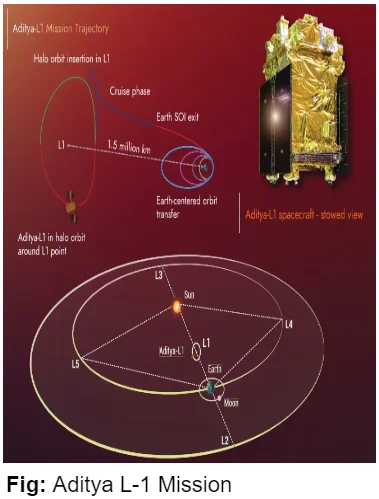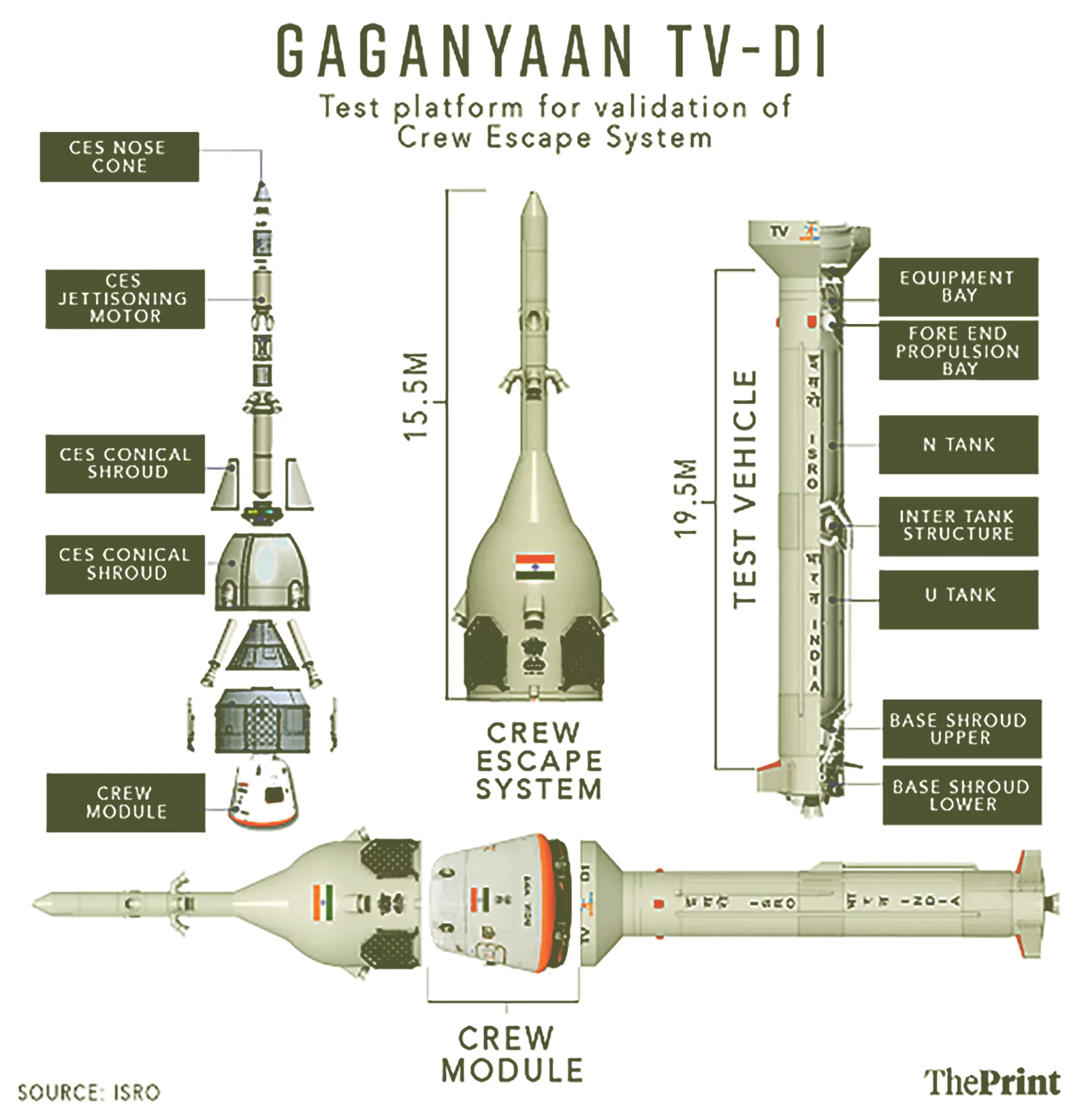Space exploration has advanced significantly with missions ranging from studying the Sun’s corona to exploring the Moon and Mars. Countries like India, the US, and Russia have achieved remarkable milestones in understanding celestial bodies and their environments. Recent developments promise new missions to further expand our knowledge of space.
An Overview Of Advancements in Space Exploration and Satellite Technology
Exploration of the Sun
- Parker Solar Probe: It is the first spacecraft to reach the solar corona’s lower layers.
- The structure and dynamics of the Sun’s coronal plasma and magnetic field will be studied.
- Parker measured particles and magnetic fields in the Sun’s upper atmosphere, known as the corona, according to NASA.

- Aditya L-1 Mission: The Indian Space Research Organisation (ISRO) is gearing up for Aditya-L1, the country’s first scientific mission to study the Sun.
- It would be positioned in the L1 Lagrange point, which is a location in space.
- Aditya L1 will be launched with seven payloads (instruments) aboard the Polar Satellite Launch Vehicle (PSLV) XL.
- It will conduct round-the-clock imaging of the Sun and investigate the corona, photosphere,chromosphere, solar emissions, solar winds and flares, and Coronal Mass Ejections.
Missions to Moon
- Numerous space missions have been launched to explore Earth’s natural satellite as part of human exploration of the Moon.
- Luna 2: The Soviet Union’s Luna 2 was the first spacecraft to reach the Moon’s surface safely.
- Luna 9: It was the first spacecraft to make a controlled soft landing, while Luna 10 was the first mission to enter orbit, both in 1966.
- Apollo: Crewed missions to the Moon were carried out by the United States as part of the Apollo programme between 1968 and 1972.
- Apollo 8 was the first crewed mission to enter orbit in 1968.
- Neil Armstrong became the first person to walk on the Moon during Apollo 11 in July 1969.
- So far, 24 humans have visited this massive landmass, 12 have walked on it.
- Recent Developments: With Artemis missions, NASA will land the first woman and first person of color on the Moon, using innovative technologies to explore more of the lunar surface than ever before.
| India’ s Missions to Moon
Chandrayaan 1
- India’s first mission to the Moon was launched in 2008.
- Chandrayaan 1 reached the lunar orbit 21 days after its launch and after making 3400 orbits around the Moon and transmitting data.
- In late November 2008, Chandrayaan 1 began experiencing abnormally high temperatures.
- The last contact with Chandrayaan 1 was on August 28, 2009. It still circles around the Moon.
Chandrayaan 2
- The failure of Chandrayaan-2, India’s second mission to the Moon, to make a soft-landing on the lunar surface had led to much disappointment.
- The lander and rover malfunctioned in the final moments and crash-landed, getting destroyed in the process
- But that did not mean the entire mission had been wasted. The Orbiter part of the mission has been functioning normally.
Chandrayaan-3
- The Chandrayaan-3 mission consists of a lander module, a propulsion module, and a rover.
- The Chandrayaan-3 Lander has solar panels on four sides, instead of only two in Chandrayaan-2.
- Chandrayaan-3 is a follow-on mission to Chandrayaan-2 to demonstrate end-to-end capability in safe landing and roving on the lunar surface.
- The spacecraft departed from the Satish Dhawan Space Centre in Sriharikota on July 14, 2023, and smoothly entered lunar orbit by August 5, 2023.
- The lander achieved a flawless touchdown near the lunar south pole on August 23, 2023.
- The total weight of Chandrayaan-3 is 3,900 kg, with the propulsion module weighing 2,148 kg and the lander and the rover both weighing 1,752 kg.
|
Missions to Mars
- Beginner: The Soviets sent a series of probes to Mars beginning in 1960.
- Mariner 9: became the first space probe to circle another planet when it entered orbit around Mars on November 14, 1971.
- Mars Global Surveyor: In 1997, NASA’s Mars Global Surveyor was launched into orbit around Mars.
- The primary mapping mission was completed in early 2001, and the mission was a perfect success.
- Mars Pathfinder: In 1997, NASA’s Mars Pathfinder landed in the Ares Vallis on Mars, carrying the robotic exploration spacecraft Sojourner.
- Mars Odyssey: In 2001, NASA’s Mars Odyssey orbiter was sent into orbit around Mars.
- Mangalyaan: ISRO launched the Mars Orbiter Mission, on November 5, 2013. (ISRO).
- On September 24, 2014, it was successfully placed into Martian orbit.
Voyager Mission
- Launch of Voyager Spacecraft: The twin spacecraft Voyager 1 and Voyager 2 were launched by NASA in separate months in the summer of 1977 from Cape Canaveral, Florida.
- Mission Objectives: As originally designed, the Voyagers were to conduct closeup studies of Jupiter and Saturn, Saturn’s rings, and the larger moons of the two planets.
- During planetary flybys, Voyager 2 is the only probe that has ever studied Neptune and Uranus.
- It is the world’s second man-made object to orbit the sun.
- Achievements of Voyager 2: Voyager 2 is the only spacecraft to have visited all four gas giant planets — Jupiter, Saturn, Uranus, and Neptune — and found 16 moons, as well as phenomena such as Neptune’s seemingly ephemeral Great Dark Spot, Europa’s ice shell fissures, and ring structures on each planet.

Gaganyaan Mission
- Overview of Gaganyaan Flights: Gaganyaan is an Indian Space Research Organisation mission (ISRO).
- Three Gaganyaan flights will be sent into orbit, according to the Gaganyaan programme.
- Two unmanned missions and one human spaceflight are planned.
- Three Indian astronauts, including a woman, will be aboard the Gaganyaan system module, dubbed the Orbital Module.
- For 5-7 days, it will orbit Earth in a low-earth-orbit at a distance of 300-400 kilometres.
- Launch Vehicle GSLV Mk III: The three-stage heavy lift launch vehicle GSLV Mk III, also known as the LVM-3 (Launch Vehicle Mark-3), will be utilised to launch Gaganyaan because it has the appropriate payload capabilities.
- Planned Missions of Gaganyaan: Gaganyaan’s important missions, including as the test vehicle flight to validate the crew escape system’s performance and Gaganyaan’s first uncrewed mission (G1), are planned for the second half of next year (2022).
- The second uncrewed trip, which will contain Vyommitra, a spacefaring human robot, will launch at the end of 2022.
Space Debris
- Types of Space debris: Space debris encompasses both natural meteoroid and artificial (human-made) orbital debris.
- Characteristics of Orbital Debris: Meteoroids are in orbit about the sun, while most artificial debris is in orbit about the Earth (hence, the term “orbital” debris).
- Orbital debris is any human-made object in orbit about the Earth that no longer serves a useful function.
- Such debris includes non-functional spacecraft, abandoned launch vehicle stages, mission-related debris, and fragmentation debris.
- There are approximately 23,000 pieces of debris larger than a softball orbiting the Earth.
- They travel at speeds up to 17,500 mph, fast enough for a relatively small piece of orbital debris to damage a satellite or a spacecraft.
- Cause of concern for Space debris
- Increasing Debris Concern: With the increasing amount of space debris and the advent of mega-constellations of thousands of satellites, there are fears that collisions such as that between Iridium 33 and Cosmos 2251 could set off a chain reaction.
- Kessler Syndrome: This chain reaction is called the Kessler syndrome, in which the resulting space debris would destroy other satellites and so on, with low Earth orbit eventually becoming unusable.
Instances of Misfortune
- French Satellite Collision (1996): In 1996, a French satellite was hit and damaged by debris from a French rocket that had exploded a decade earlier.
- Russian-US Spacecraft Collision (2009): On Feb. 10, 2009, a defunct Russian spacecraft collided with and destroyed a functioning U.S. Iridium commercial spacecraft.
- The collision added more than 2,300 pieces of large, trackable debris and many more smaller debris to the inventory of space junk.
- China’s Anti-Satellite Test (2007): China’s 2007 anti-satellite test, which used a missile to destroy an old weather satellite, added more than 3,500 pieces of large, trackable debris and many more smaller debris to the debris problem.
IRNSS-Navic [Upsc 2018]
- Overview: The Navigation with Indian Constellation (NavIC) satellite system is an autonomous regional navigation satellite system that provides location data in the Indian area and 1500 kilometers surrounding the Indian landmass.
- Services Provided: IRNSS would offer two types of services Standard Positioning Services, which would be available to all users, and Restricted Services, which would only be available to permitted users.
- Satellite Configuration: There are seven satellites in all.
- Three will be geostationary above the Indian Ocean and .
- Ground Station Coverage for NavIC: This setup assures that at any one moment, at least one of fourteen ground stations is tracking each satellite, with a good likelihood that most of them will be visible from anywhere in India.
GEMINI and Disaster Management
- GEMINI Device: Gagan Enabled Mariner’s Instrument for Navigation and Information (GEMINI) device.
- GEMINI is a portable satellite receiver connected to ISRO spacecraft.
- Because the gadget can send signals up to 300 nautical miles, fishermen beyond the signal range of their phone providers (i.e. 10-12 km) may also obtain warnings and alarms.
- Enhancing Satellite-Based Communication: It will make satellite-based communication easier, which will be especially important in the event of storms, strong seas, or tsunamis.
- Collaboration on GAGAN: The Indian Space Research Organization (ISRO) and the Airports Authority of India collaborated on GAGAN.
- It is India’s first satellite-based global positioning system, relying on the GSAT satellites of ISRO.
- Limitations of GAGAN Technology: The disadvantage of this technology is that it only permits one-way communication, which means that fishermen cannot use it to make calls.
Conclusion
As space technology evolves, missions like Gaganyaan and Chandrayaan-3 demonstrate India’s commitment to exploring beyond Earth.
- Challenges like space debris highlight the need for responsible space exploration.
- Advancements in navigation systems and disaster management tools continue to improve our ability to explore and utilize space effectively.
![]() June 17, 2024
June 17, 2024
![]() 1429
1429
![]() 0
0

